Denis O’Regan on photographing David Bowie on ’83’s Serious Moonlight Tour
SDE interview with the photographer • Penguin edition of ‘Ricochet: David Bowie 1983’ book is out today • Collector’s edition also available
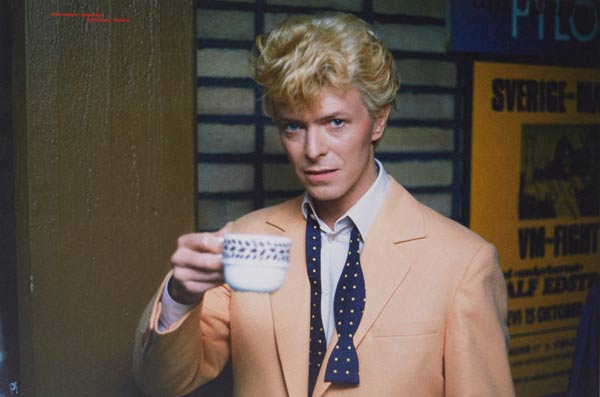
Back in July SDE told you about Ricochet: David Bowie 1983 a limited edition art book with photographs by Denis O’Regan taken on Bowie’s Serious Moonlight Tour.
That lavish and highly priced tome (which incorporates four supplementary volumes, a vinyl record and three prints) is still available via the official website, but today sees the release of a smaller, more affordable version by Penguin imprint Particular Books. To mark this occasion SDE publishes in full its interview with Denis O’Regan from earlier on this year where we discussed the book and his time on tour with David Bowie in 1983.
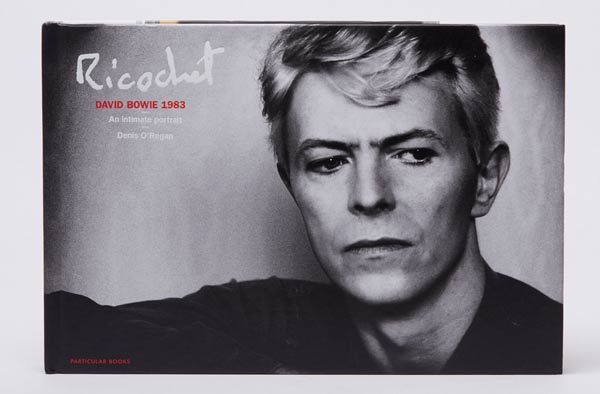
The Particular books edition is a 12″ x 8″ hardcover volume in landscape format
SuperDeluxeEdition: I suppose the first thing to ask is how you got the gig working with David? I know you’ve done the Rolling Stones before that, hadn’t you?
Denis O’Regan: Yeah, I’d done the Stones the year before. It’s a quick series of events really. Seeing Ziggy Stardust [the live concert], first of all… that inspired me. Then I travelled around Europe the next year, and I got hooked on travel and taking pictures as I travelled for eight or six weeks, whatever it was. Just before I went, I was working in local newspaper shops. Two girls came in wanting paper and pens, giggling, and I realised that David was recording Diamond Dogs across the road – this is the area I where I lived! So I went home, got my five-quid camera, came back, hung around, went and took some pictures of David. So then by 1978, I was doing most of NME’s pictures, so I asked if I could go and shoot David at the Newcastle City Hall. And then I started going on tour with Thin Lizzy from the next year, and then the Stones, and on the Stones tour I was working this tour accountant and then I read that he was putting together a David Bowie world tour, for the next year, so I got in on that.
He said we’ll need a business plan to put to David about what you want to do and how you want to do it, and so I said I’ll do a book [published in the UK in 1984 as ‘David Bowie: Serious Moonlight – The World Tour‘] , so that is what got me on the tour. I said I’ll do a book and we’ll do a deal on the income and costs and all the rest of it, and off I went. But I wasn’t to know I would be on the whole tour. I went to rehearsals in Texas and they sort of checked me out for a few days; David checked me out, I suppose, and then they said, yeah, you’re on the tour, and that was it.
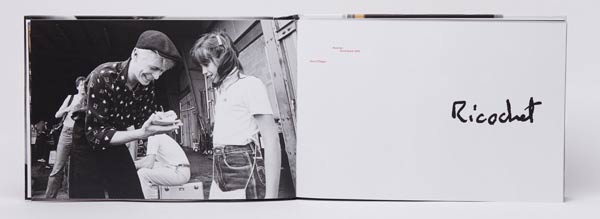
A spread from the Particular Books edition of Ricochet: David Bowie 1983 (click image to enlarge)
SDE: How long was the tour? It was quite a long tour.
DOR: Eight months.
SDE: And you were on the whole thing?
DOR: Yeah, from that day at rehearsals right the way through.
SDE: You were part of the entourage?
DOR: Yeah, well the entourage is David, the band; that was already about ten people with all the backing musicians. Security, admin, makeup, wardrobe, accountant, tour manager… all that lot, and me, so that was the touring party that travelled with David.
SDE: And had he given you a specific brief?
DOR: No. What the idea was, I said I wanted to do this book, so David was aware of what the book should be, which should be a lot of offstage – not loads and loads of live. At first, I thought it was going to be very arms-length, but in fact he wanted more and more pictures taken. He said, do this, do that, shoot this, shoot that, and I thought, wow… instead of being pushed away I’m being pulled in and he’s making demands. So that was great. So, he just gave me more and more access and I spent a huge amount of time with him.
SDE: What was your routine? Were you just echoing David’s routine during the day? Would he say to you, “I’m going to go into town today, do you want to come with me?”
DOR: I suppose there were three types of days, really. So there’s a travel day; so you get up when you’re told to get up. Well, you’re in the lobby when you’re told to be in the lobby, and you get a newsletter under your door every night, says be in the lobby at this time, leave your bags outside the door before that, at this time. Someone comes round and collects all the suitcases and they’re taken to the plane. So, then we have to be in the lobby at a certain time; they would tell us, you know, when the flight was and how long it was, where we were going, what the venue was. So that was our day, we followed that routine. So the travel day, you do as you’re told.
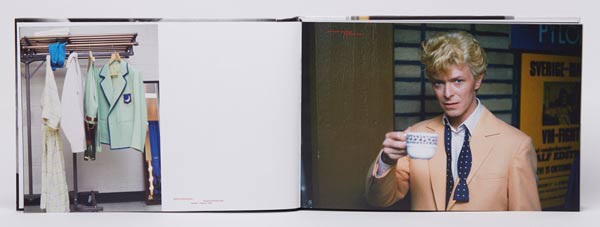
A spread from the Particular Books edition of Ricochet: David Bowie 1983 (click image to enlarge)
Day off, you do what you want, but if David was doing something unusual he might ask you go with him, so that answers that question really.
And our show day and the travel day might be the same day, sometimes they’re not. So you might arrive somewhere and then you’ll just relax and maybe go out to dinner. And whoever goes out to dinner with whoever, it’s just the pick of the draw. Someone says, “shall we do this?”, or there might be a tour thing going on that night, there might be a dinner that we’re expected to go to, or it might be a special event, so we all go to that. Or David might be going out on a private dinner and he’ll say, come along. So that would have been my night off [laughs], so instead of that I travelled with David and go out with him. I’d stay in with him for the evening and do what he’s doing. Sometimes during the day, he might be going somewhere interesting, in which case I might come along, or always to take pictures but not always there because I’m taking pictures.
So I might go along and not do pictures, apart from five minutes, just to capture whatever it was he was doing. In East Berlin, we crossed from West to East and went to a giant museum, and just walked around this huge architectural type museum, or I’ve mentioned before, that in Berlin, after the sound check we’d decide we’d go round to his apartment, and I haven’t been there in 20 years, 25 years…
SDE: That must have been really interesting.
DOR: Well, it was weird, because he just came offstage, you know, after the sound check and just said shall we go round to my old apartment. Okay, so off we go. But of course, it wasn’t legendary then, you know, it was just where he’d lived a few years before.
SDE: Hang on, so that must have been the next tour, was it?
DOR: Yes, so this [occasion] wasn’t ’83, it was ’87. Yeah, he just knocked on the door and the bloke opened it. He said, “oh, hello, I’m David, I used to live here, do you mind if we pop in?” And the guy went, “yeah, fine,” and David thought it was really funny that the guy kept his cool so well. David really liked seeing it, it was a really high-ceilinged apartment.
SDE: Tell me a bit about your and David’s relationship, because it must have developed – did you feel like you were buddies at the end?
DOR: Well, much sooner than that.
SDE: Presumably, if you’re not getting on with someone or you don’t feel it’s natural, then…
DOR: … then I wouldn’t have been there – it wouldn’t have worked. He probably knew in those first few days. We got on well, it was easy, I wasn’t hassling him, which he probably liked. Well, he hassled me more than I hassled him, as time went on, but, you know, he knew I wasn’t going to be a pain… “do this, do that, do the other..” you know, hiding behind doors or any of that. And really, I mean I was more reticent about taking pictures really than he wanted me to be, so, you know, you spend a lot of time, you travel together.
So on those show or travel days, when you first get up, David’s right there, so you get a bus to the plane, then you’re on the plane together, and then you get there and you might to sound checks. So you’re there, and then quite often, if we did that, we’d travel over to sound check and then the show, we’re together from morning till night. And we might fly again after the show. So we might have spent 16, 18 hours together, just in that one day, off and on.
So it can be quite a concentrated… and then we did social things together, or it might just be me and him, or me and him and Coco [Corinne Schwab, Bowie’s longtime personal assistant], or me and him and Coco and a friend.
SDE: How did the man differ, if at all, from your preconceptions of what he might have been like before you knew him?
DOR: Well, he was much more approachable than I ever expected. So here was this huge star who I was a fan of, so that made it even worse. And then the first day at rehearsals, he called me down to the front, this huge place [and said] “what do you think of the tracks we’ve played, the songs we’ve played, which ones do you think we should keep in the show?”
So then after rehearsals each day, he went boxing, and I went along with him, and that was really I think my audition, because it was just us, Coco, and Tony, the driver. So it was the four of us, and we would go to the boxing every day for those first weeks, I’d say. So we were in close proximity for a big chunk of that time, and I think that was when he figured out that we were getting along okay. And he was much more approachable, funny – not aloof.

A spread from the Particular Books edition of Ricochet: David Bowie 1983 (click image to enlarge)
He was completely different to the star that I thought I was going to be dealing with, and it made the relationship much easier. If you’re photographing someone all the time, it can probably be, from his point of view, a bit irritating I suppose. But it was what he wanted. He wanted those photographs. But it’s the personal [stuff], you know – you’re together as two people a lot more than you are as the photographer and the subject, because I wouldn’t take pictures all the time. So there were two sort of relationships in a way.
SDE: Would he make suggestions about the next day… “maybe we should do this. Could you do this, that or the other?”
DOR: Not usually in advance, but at the time he definitely did – “why don’t you do this, why don’t we go there.” But the choice of photographs was nearly always mine, and I’ve seen when he’s posed for photographs with other photographers, where I really think that most of the time they’re letting him do his thing, because he’s so good at it.
You know, I never said to David “move your head to the left…” – why would I do that? A, he knew what he was doing; B, he looked amazing, and C, I was really documenting him offstage, it wasn’t a studio session, it wasn’t posed. We had the slideshow in my [hotel] room, so I would get the films developed and sent back.
SDE: So he’d come and look at them with you?
DOR: Yeah. So I’d get them back, go through them and do a selection, and put them on a carousel projector. And then he’d come to my room, and that was great ’cause that really was just the two of us and the two of us talking about the pictures and not working as such. So we would just chitchat. I found some recordings the other day I made, audio recordings, of the ’87 tour. I thought I might do a little recording of David every day, and I’d have all these soundbites, eight or nine months of soundbites. After a week I got fed up with it, so I thought I should be taking pictures not doing this. But I found one the other day, and it was just the two of us talking complete rubbish. We were singing old advert jingles and things from way back when…
SDE: That must have been quite emotional, hearing his voice…
DOR: Oh, it was, it was, yeah, it really was. And I also had a recording of a lunch that we had and various chit-chat.
SDE: David’s mood must have been quite buoyant on the 1983 ‘Serious Moonlight’ tour because he had a massive hit album and he had more probably adulation than he had ever had on a global scale. How did his moods compare between the two tours? Because I think by the time he got to the ‘Glass Spider’ tour, you know, things were slightly different. He was maybe getting fed up with producing the kind of music he was doing. He was perhaps thinking maybe about doing something different.
DOR: Well, he was used to fame, the global adulation, so he was already used to that so it wasn’t new. The huge shows weren’t new, whereas on Serious Moonlight they were. They started off as much smaller shows and developed into big ones. He’d had a huge album in 83, which he didn’t have in 87. The reviews weren’t great in 87, so all of those things, I think David did a second huge tour because maybe he was… you know, it was suggested and he went along with it. But even though it was a big tour, he wanted it to be a B-sides tour, not a hits tour, but after that of course they cut the whole big tour thing off.
SDE: I was at the Sound and Vision tour in Milton Keynes, actually, and that was him, supposedly doing the hits for the last time, but obviously it wasn’t in the end…
DOR: I think he developed a lifestyle over the previous seven years and it was a lifestyle that depended on that kind of income.
SDE: David was reasonably well known for having a fear of flying. It’s obvious from your photos in ‘Ricochet’ that he was flying a lot. How did he conquer that?
DOR: I don’t know how he conquered it, but he was told that if you want to do this huge tour – and it turned out to be bigger than they thought – if you do it, you have to fly, and that’s the end of it. So he obviously just made a decision that if he was going to do this he’d have to put up with it. But there were a few scary moments, a few scary plane rides along the way, yeah. He had a Concorde incident as well, where it was coming down onto the runway and then takes off again. He wasn’t too impressed, probably because it was so loud when it took off again.
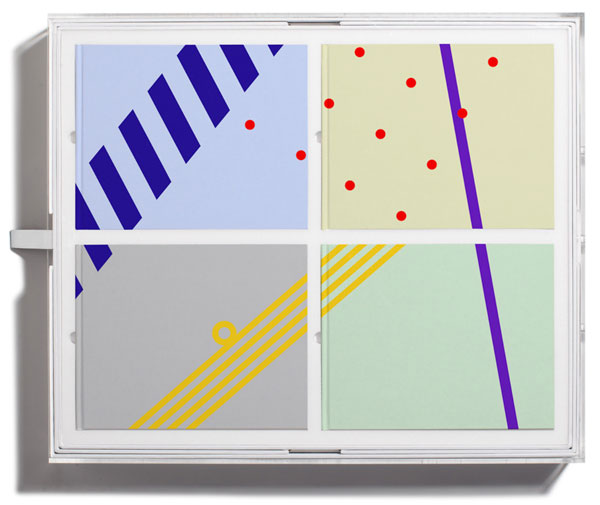 The collectors’ edition of Ricochet includes four smaller books
The collectors’ edition of Ricochet includes four smaller books
SDE: Let’s talk specifically about the new book. Obviously, by all accounts, it’s something you’d been discussing with David for a while, and it says that, he personally approved all the pictures. I mean tell me a little bit about the timescale and when David would have been involved.
DOR: Well, the pictures were [already] approved. So it’s not a new selection of pictures, that he’d newly approved. It’s just that they’d been approved all along. And in the little book [four ‘little’ books form part of the large limited edition art book version of Ricochet] you’ll see the contact sheets and what he did and didn’t approve. So yeah, it goes back to then. We knew years ago that the 1980s boxed set was planned for this year. So that then would coincide with this book, so that’s what that was about really.
SDE: The lavishness of the limited edition ‘arty’ version of Ricochet, with the four little books – who came up with those concepts?
DOR: Originally, it was one book, and we went to the designers, it was as simple as that. But it wasn’t four little books; originally it was supposed to be five big books. And I said it’s going to weigh a ton, you just can’t do that, so we turned it into one [big] book at the bottom and four on top. So it was a kind of artistic thing, it all came about that way.
SDE: With the old book [the 1984 ‘Serious Moonlight’ publication] there was more text and it felt more collaborative…
DOR: Yeah.. I mean obviously I wanted this [Ricochet] to be a photography book. And the old one, you know, has little pictures in it and there are political reasons for having some pictures in there [Denis points to an image in the old book, which I had with me for the interview and points to an image] “That’s his manager, you see, so we had to have a picture of David and Bruce. And I didn’t want any of that in the new book, I wanted it to be purely artistic merit, let’s say. And not have the photos chopped in half by the seam!
And to show the context of a lot of the pictures. So the great thing about having more than one book. The big book is to show off the pictures, the smaller books will show off the context. So here’s one of David, and here are 20 or 30 that surround that one picture, so you can put it into context. I really, really like that, and of course the content of those four extra books isn’t going to into the [cheaper] Penguin book. So the Penguin book is only the big photographs in the big book.
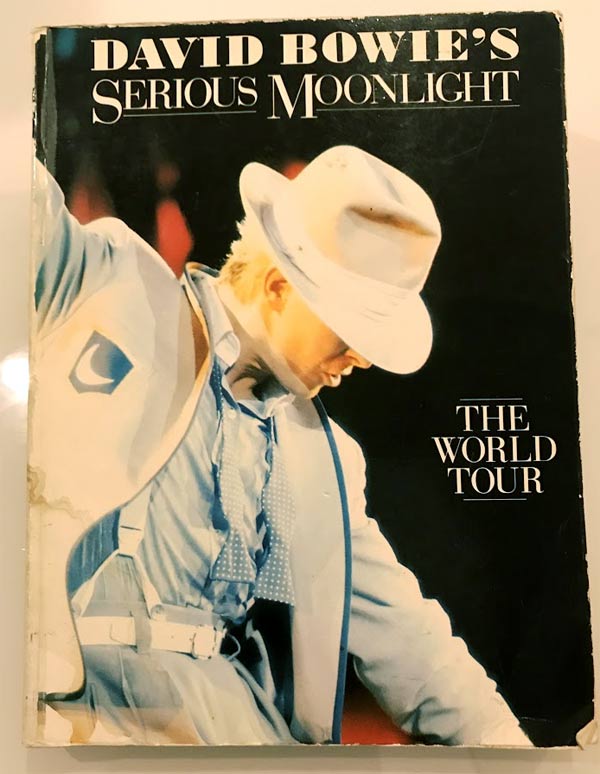 O’Regan’s photos had previously been collected in this 1984 publication.
O’Regan’s photos had previously been collected in this 1984 publication.
SDE: When you were on the tour, what would you say were the main challenges in terms of doing your job and getting the outcome that you wanted? I mean, is there such a thing as kind of getting too close to the subject?
DOR: [wryly] Yeah, probably. You’ve got to make sure you don’t fall out. There will be issues. One always gets pissed off about something, it’s just life. A very concentrated chunk of life, so it’s eight months but it feels like ten years, so you end up having ten years of your life is in that. So everyone becomes ill, has bad moods, there’ll be affairs going on… there’s all sorts of stuff going on. So it’s a microcosm of life.
And the two of us will have our differences, because it’s not the star and the photographer anymore, it’s the two people … And this is what I mean about what I was saying about touring. Touring itself is really difficult. You’re flying all over the place every day, you’re eating strange food. You’re stuck with the same people day in, day out, which can drive you insane, and you’re cooped up as well. You’re in that plane together, you’re in that dressing room together, you’re having dinner together.
SDE: Did David cope with that well?
DOR: Yes, and the pressure on him is enormous, obviously, compared to the rest of us. He’s got to carry the whole thing, so he’s got to be as happy as possible and as healthy as possible, as fit as possible. And he has people to help him to do that, obviously…
SDE: Yes, he had these trusted people, like Carlos [Alomar] as bandleader and Coco, of course. Coco was, kind of, his rock really, wasn’t she?
DOR: Yes.
SDE: It must have been interesting to witness that relationship because it’s not something that many people have really got close to.
DOR: I never experienced it [that kind of relationship] and I’m not sure that many people have it, you know, but it was very, very close, over a long period of time. And in 87, of course, that album was [Never Let Me Down] was dedicated to her, and named after their relationship. And she was not only his rock, she was all different things. She was his portcullis, you know, his drawbridge, and she looked after him and kept him away from…
SDE: Told people to ‘piss off’, effectively?
DOR: Yeah, more often than not. And of course I had to deal with that relationship. Me and David would have been easier. It’s a bit like Diana, there are three people in this marriage… I’ve never thought of this before.
SDE: Does that mean she’d come over and question why you were doing something?
DOR: No, it was usually why aren’t you doing this, you should be… This is what I mean, and this is what I did not expect. It wasn’t you’re doing too much, definitely not, it was why weren’t you there, you know, make sure you’re here, that sort of thing really.
SDE: You and David weren’t that far apart in age at the time. Do you think that helped?
DOR: Yeah, but he’s still, to me he was a star when I was at school, so it was still that thing.
SDE: Does that mean you could never got rid of that little thing in your brain reminding you that he’s a rock star?
DOR: Not quite. But, as you say, the age difference wasn’t huge, so when we were together there was no age difference, definitely not. Between all of us, we were all, you know, roughly the same decade, I suppose, the band and everyone, so we were all the same age, but, you know, Ziggy Stardust… I saw him play live as I left school, so he’d already been through everything before that, when I was a schoolboy. So there is that difference.
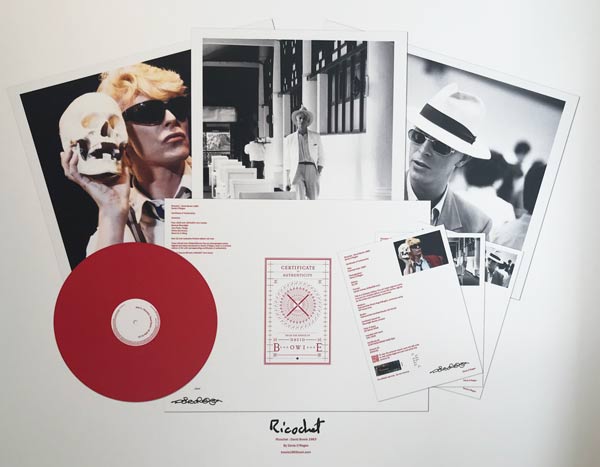
The collectors’ edition includes prints, red vinyl and an Estate-stamped certificate of authenticity
SDE: And would you ask him about the old days when you were on tour?
DOR: Oh, he would usually tell, yeah. He had story after story after story, so he would just come out, remind you of what he did and what Iggy did and what Mick did. He was full of stories, because he had great conversations with them and a lot of stuff would come out of that.
SDE: And he crammed so much into that decade in the 1970s, didn’t he? The touring and the albums…
DOR: Yes, but he only did two tours in the 1980s… well actually from 1978 to ’90, so 12 years he did two tours in between those two. And of course, Scary Monsters had never been a tour, so there was an extra album, a spare album to happen on this tour, so I think that also bolstered the show and made it more interesting for everyone, ’cause those songs had never been played live. So he had two albums of stuff that had never been played live.
SDE: And are you planning to do another book? I guess probably not to this scale?
DOR: No. This took on a life of its own. It got out of hand. You know, we had intended to do what we did, we saw it through and it was amazing and I love it, but I think the next one should be… it’s a bit like you do a huge tour, and you have days when you say, no, I’m not doing that again! You know, I want to be in a band next time, which is what he said [after the 1987 tour]. And I feel the same way, that the next book should be simpler, where you have more of it, more content, but just a pared down.
SDE: But are you pleased with how ‘Ricochet’ has turned out?
DOR: I love it, love it. I really am very, very proud of it. We were so pleased when it came in the other day, because there’s a vast amount of content. You just couldn’t get all of that into a normal book, so because that’s al there… And those collectors items and those prints have a value outside of the boxed set. So I’m really pleased with it, but I think the next one should be more of a book and less of a collection.
SDE: Have you got any idea at this moment in time when the next book might happen?
DOR: 18 months, two years. It won’t be that long, because I’m in the mood and, you know, we’re on a roll in a way and I’m dealing with all the stuff to do with David. And when I went through his archive, I actually chose a lot of stuff for the next book as well. It has a different feel too…
SDE: His haircut isn’t as good [laughs]
DOR: Well, it is sometimes when it’s not all standing on end! But we knew each other better by then, so that made it looser and a bit more fun, in a way. You know, we knew each other really well, and also it was a slightly grittier tour. In my mind, I see a lot of black and white on that tour. You have the dancers, you have David going to Berlin and Hansa and all those things, which created a different story. This one had more about the Let’s Dance look.
SDE: That’s quite interesting. And have those photos ever been published?
DOR: Well, some of them have been published but, unlike with this book, there were fewer. So there’s a massive amount of unseen stuff. And they were really completely different situations, it’s quite odd how the two tours are so different. You know, one’s all about stadiums, and the second one is all about stadiums, but it’s much more about David… you know, I shot him by the Berlin Wall and things like that, which are so different. We’d been to Berlin on the first tour, but we sort of ricocheted off it, you know, and this time, in 87, we were there almost in-depth, so a very, very different tour.
SDE: Do you look at this as a career highlight for you?
DOR: Oh yeah. Well, the ‘Stones was my first big tour, and I went from Thin Lizzy to the Rolling Stones, so the biggest band in the world. And that threw me a bit at first. You get used to it very quickly.
SDE: But one gets the feeling that the Mick Jaggers of this world are a bit more arms-length than say David was?
DOR: Yeah, and I was there for less time. I was there for two months. There were five of them. You know, a big thing about being on tour with David is it’s one person. So he had all my attention…
SDE: There’s that funny quote about David saying something like when you’re a solo artist you can’t split up with yourself
DOR: You’re only one person, exactly. And also, when you have more than one person in the band there’s politics between them, and you’ve got to cover each one as much, you don’t want to be seen with one person too much. Whereas with David, it was all David, David, David, and so there’s a concentration of pictures.
SDE: And did you stay in touch with David, as time went by and we went into the 90s and the 2000s?
DOR: Not so much, no.
SDE: When was the last time you had a conversation with him?
DOR: I don’t know, late 90s, early 2000s, yeah, it was quite a while back. All of these different things were going on. I mean it was quoted, you know in terms of what he’s been up to, that he was going through his loft, and that is what he was doing! And he was going through his loft, getting stuff ready for V&A and preparing his legacy, ’cause he knew he was closing things down, and he wanted everything to be in its place. And, you know, we’ve got the Estates stamp on the certificate [that comes with the collector’s edition of the book], which Jonathan Barnbrook designed, well it’s based on the stamp that David had put in all his books. He didn’t want books going out saying this was David’s when it wasn’t, so he had a stamp created that went into each one. So we go it redesigned. It will be used for other stuff, but this is the first time it’s been used.
Thanks to Denis O’Regan who was interviewed for SDE by Paul Sinclair
The signed and numbered limited edition (of 2000) version of Ricochet: David Bowie 1983 is a clothbound hardcover book with four supplementary volumes, limited edition vinyl and three limited edition prints housed in an acrylic slipcase. It can be ordered via the official website.
The new smaller edition, by Penguin imprint Particular Books, is released today. It’s still a beautiful volume and incredibly good value.
Compare prices and pre-order

O'Regan, Denis
Ricochet: David Bowie 1983 - Particular Books edition

|
|
||||||||||||||||||||||||||||||||||||||||||||||||||||||||||||

 Interview
Interview
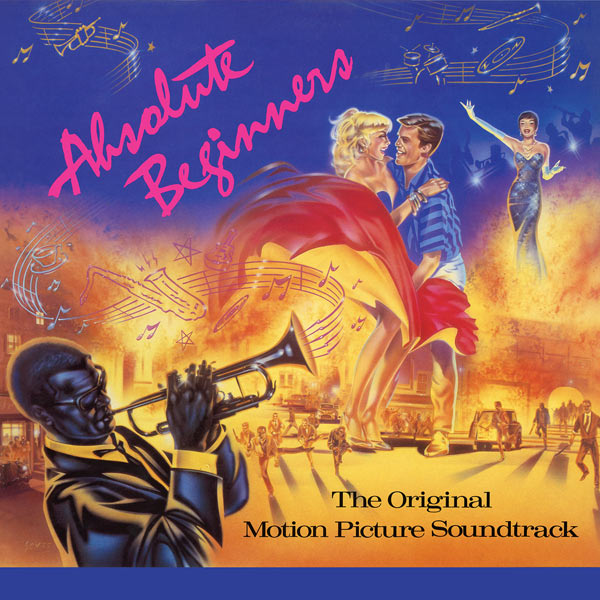
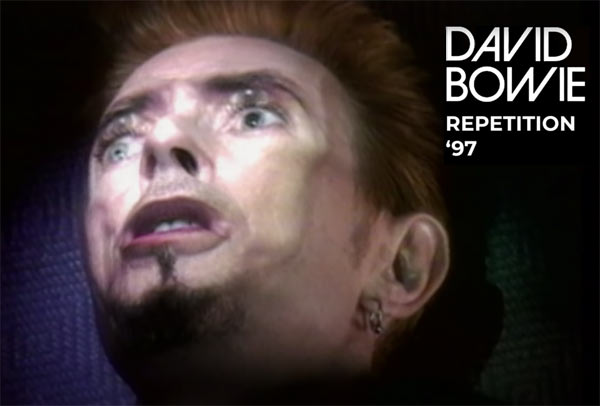
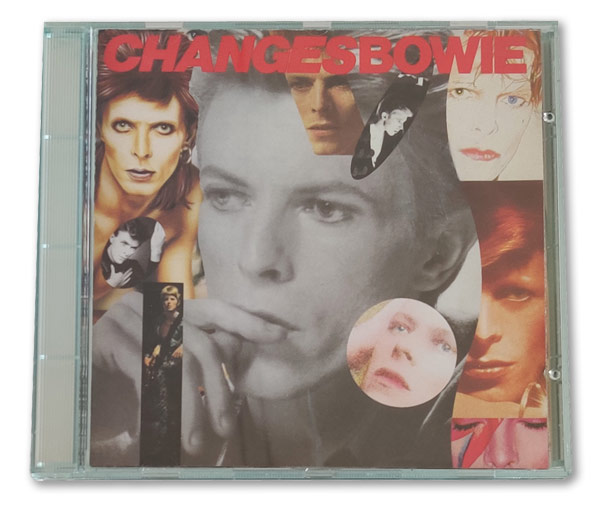
By Paul Sinclair
12